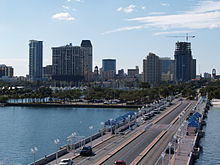The following is a complete list of the 22 metropolitan areas in Florida, as defined by the United States Office of Management and Budget. The largest, the Miami metropolitan area, is the ninth-largest among metropolitan areas in the U.S. The second-largest metropolitan area in Florida, the Tampa Bay area, is the 17th-largest metropolitan area in the nation.
Metropolitan areas
The following table lists population figures for those metropolitan areas, in rank of population. Population figures are as of the 2023 U.S. Census estimates.




| Florida rank |
U.S. rank |
Metropolitan area | Population (2023 est.) |
|---|---|---|---|
| 1 | 9 | Miami–Fort Lauderdale–West Palm Beach | 6,183,199 |
| 2 | 17 | Tampa–St. Petersburg–Clearwater | 3,342,963 |
| 3 | 21 | Orlando–Kissimmee–Sanford | 2,817,933 |
| 4 | 38 | Jacksonville | 1,713,240 |
| 5 | 63 | North Port–Bradenton–Sarasota | 910,108 |
| 6 | 72 | Cape Coral–Fort Myers | 834,573 |
| 7 | 75 | Lakeland–Winter Haven | 818,330 |
| 8 | 83 | Deltona–Daytona Beach–Ormond Beach | 721,796 |
| 9 | 91 | Palm Bay–Melbourne–Titusville | 643,979 |
| 10 | 106 | Port St. Lucie | 536,901 |
| 11 | 107 | Pensacola–Ferry Pass–Brent | 530,090 |
| 12 | 134 | Ocala | 409,959 |
| 13 | 135 | Naples–Marco Island | 404,310 |
| 14 | 141 | Tallahassee | 392,645 |
| 15 | 157 | Gainesville | 352,126 |
| 16 | 170 | Crestview–Fort Walton Beach–Destin | 304,818 |
| 17 | 218 | Panama City–Panama City Beach | 216,371 |
| 18 | 225 | Punta Gorda | 206,134 |
| 19 | 257 | Sebastian–Vero Beach–West Vero Corridor | 169,795 |
| 20 | 263 | Homosassa Springs | 166,696 |
| 21 | 286 | Wildwood–The Villages | 151,565 |
| 22 | 348 | Sebring | 107,614 |
See also
References
- "Metropolitan and Micropolitan Statistical Areas Population Totals: 2020-2023". United States Census Bureau, Population Division. March 14, 2024. Retrieved August 31, 2024.